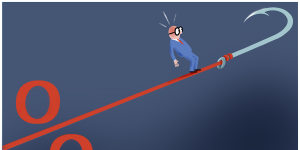In Heller’s work,a catch-22 situation was illustrated with the case of a bombardier who was clearly “crazy” and should be grounded from flying. But to ask to be relieved of duty showed he was sane.

A scene from the miniseries adaptation of Catch-22. The Reserve Bank is confronting its own policy paradox. Philippe Antonello/Stan
The Reserve Bank board minutes may not be as well written as Heller’s work,but they also show the tough position the bank finds itself in trying to deal with high inflation by pushing up interest rates.
The best example of the RBA’s catch-22 is that its increases in interest rates can actually contribute to inflation.
The Consumer Price Index is a notional basket of goods and services. Every year,the Australian Bureau of Statistics re-evaluates that basket to see if our spending patterns have changed.
Imagine you have $100 a week to spend on everything you need (and desire). The ABS reckons we spend about $17.18 of that $100 on food and non-alcoholic beverages. We spend $10.99 on all forms of transport,10¢ on postal services,16¢ on books and $1.16 on insurance.
The single largest expense,however,is housing at $22.24.
This expense has fallen in the past two ABS updates of its inflation basket. In the most recent,in December last year,the bureau noted the importance of rent had fallen due to “a relatively small increase in both the number of dwellings rented and rent prices”.
As we all know,the situation has dramatically changed. Rents are now climbing at their fastest pace since late 2009 and vacancy rates nationally are at historic lows.
On Monday,the found a median income household needs to spend 30.8 per cent of their income to service a new rental. That’s the highest proportion since mid-2014. If you’re in a lower income household,you would need to spend an eye-watering 51.6 per cent to keep a rental roof over your head.

Illustration by Andrew Dyson
By pushing up interest rates,the RBA is actually pushing up the costs incurred by landlords who are carrying mortgages on their properties. While some of those costs will be shifted on to the nation’s taxpayers via the deductions they claim,the most immediate impact will be on tenants who endure an increase in their weekly rent.
The minutes of the RBA’s May 2 meeting noted the pressure on the property market because of high population growth. Ordinarily,builders and investors would respond to that population growth by building more homes. But the bank’s higher interest rates aimed at curbing inflation are making it tougher to build those homes.
“Incentives to expand residential building had been impeded by high construction costs,the increase in interest rates and construction delays,including because of labour shortages,” the May 2 minutes say. Yep,the incentive to build more homes is being dented by the increase in interest rates.
The bank has often mentioned the importance of both wages and productivity growth. But as the recent minutes say,it’s difficult to get productivity growth in government-funded services.
Apart from talking about productivity growth,how does the RBA get businesses and workers to become more productive? It can’t,directly.
The bank has often bemoaned the high “hurdle rate” set by businesses to make productivity-improving investments in their operations. Even with interest rates in the cellar,businesses were reluctant to borrow money.
So,you can rightfully ask if higher interest rates will encourage businesses to borrow cash for new machines or hurt their bottom line by eating into the sales to potential customers.
Every three months,the RBA releases its statement of monetary policy that contains a fresh set of economic forecasts. The most recent statement was released three days after the RBA’s May meeting.
It showed the bank expects economic growth this year to slow to just 1.25 per cent (it would be far,far worse if not for Australia’s strong population growth). It believes unemployment will climb,that inflation will slow (but still remain above its target band) and that consumers will effectively close their wallets and purses.
Those forecasts are based upon a key variable – the official cash rate. When the forecasts were put together,the assumption was the cash rate would reach about 3.75 per cent. That assumption is based heavily on what financial markets and economists expect the RBA will do on interest rates.
In a question that rivals the eternal “which came first,the chicken or the egg”,do the forecasts depend on the cash rate reaching 3.75 per cent,or would the cash rate hitting that level depend on how the economy pans out?
The main reason the RBA is lifting rates is to reduce the cash available to people to push up the price of goods and services. But those “people” are mortgage holders – about a third of the population.
The higher interest rates are actually delivering an income boost to the people who have money in an interest-bearing account (who easily outnumber those with a mortgage). So,the bank is reducing the income of some in the community,while increasing it for others.
In Heller’s book,the main character Yossarian realises that catch-22 doesn’t actually exist. As it’s not real,there’s no way to get rid of the “law”.
What is real is the difficulty facing the Reserve Bank as it tries to find a way to bring down inflation. Except when it’s adding to it.
The Opinion newsletter is a weekly wrap of views that will challenge,champion and inform your own..